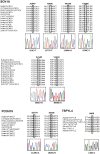Identification of SCN1A and PCDH19 mutations in Chinese children with Dravet syndrome
- PMID: 22848613
- PMCID: PMC3405017
- DOI: 10.1371/journal.pone.0041802
Identification of SCN1A and PCDH19 mutations in Chinese children with Dravet syndrome
Abstract
Background: Dravet syndrome is a severe form of epilepsy. Majority of patients have a mutation in SCN1A gene, which encodes a voltage-gated sodium channel. A recent study has demonstrated that 16% of SCN1A-negative patients have a mutation in PCDH19, the gene encoding protocadherin-19. Mutations in other genes account for only a very small proportion of families. TSPYL4 is a novel candidate gene within the locus 6q16.3-q22.31 identified by linkage study.
Objective: The present study examined the mutations in epileptic Chinese children with emphasis on Dravet syndrome.
Methods: A hundred children with severe epilepsy were divided into Dravet syndrome and non-Dravet syndrome groups and screened for SCN1A mutations by direct sequencing. SCN1A-negative Dravet syndrome patients and patients with phenotypes resembling Dravet syndrome were checked for PCDH19 and TSPYL4 mutations.
Results: Eighteen patients (9 males, 9 females) were diagnosed to have Dravet syndrome. Among them, 83% (15/18) had SCN1A mutations including truncating (7), splice site (2) and missense mutations (6). The truncating/splice site mutations were associated with moderate to severe degree of intellectual disability (p<0.05). During the progression of disease, 73% (11/15) had features fitting into the diagnostic criteria of autism spectrum disorder and 53% (8/15) had history of vaccination-induced seizures. A novel PCDH19 p.D377N mutation was identified in one SCN1A-negative female patient with Dravet syndrome and a known PCDH19 p.N340S mutation in a female non-Dravet syndrome patient. The former also inherited a TSPYL4 p.G60R variant.
Conclusion: A high percentage of SCN1A mutations was identified in our Chinese cohort of Dravet syndrome patients but none in the rest of patients. We demonstrated that truncating/splice site mutations were linked to moderate to severe intellectual disability in these patients. A de novo PCDH19 missense mutation together with an inherited TSPYL4 missense variant were identified in a patient with Dravet syndrome.
Conflict of interest statement
Figures



References
-
- Audenaert D, Van Broeckhoven C, De Jonghe P. Genes and loci involved in febrile seizures and related epilepsy syndromes. Hum Mutat. 2006;27:391–401. - PubMed
-
- Singh R, Andermann E, Whitehouse WP, Harvey AS, Keene DL, et al. Severe myoclonic epilepsy of infancy: extended spectrum of GEFS+? Epilepsia. 2001;42:837–844. - PubMed
-
- Dravet C. The core Dravet syndrome phenotype. Epilepsia. 2011;52:3–9. - PubMed
-
- Dravet C, Bureau M, Oguni H, Fukuyama Y, Cokar O. Roger JB, Dravet C, Genton P, Tassinari C, Wolf P, editors. Severe myoclonic epilepsy in infancy (Dravet syndrome). 2005. pp. 89–113. editor. Epileptic Syndromes in Infancy, Childhood and Adolescence. London: John Libbey. - PubMed
-
- Harkin LA, McMahon JM, Iona X, Dibbens L, Pelekanos JT, et al. The spectrum of SCN1A-related infantile epileptic encephalopathies. Brain. 2007;130:843–852. - PubMed
Publication types
MeSH terms
Substances
LinkOut - more resources
Full Text Sources
Other Literature Sources

